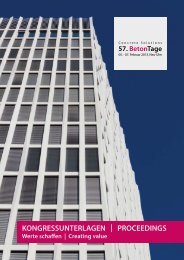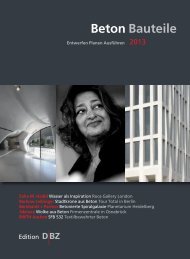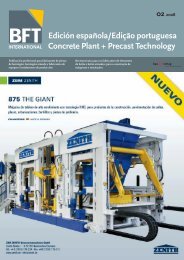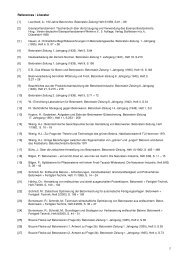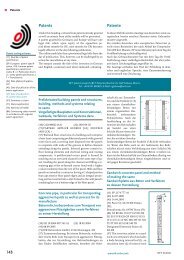Concrete Plant + Precast Technology Betonwerk ... - BFT International
Concrete Plant + Precast Technology Betonwerk ... - BFT International
Concrete Plant + Precast Technology Betonwerk ... - BFT International
Erfolgreiche ePaper selbst erstellen
Machen Sie aus Ihren PDF Publikationen ein blätterbares Flipbook mit unserer einzigartigen Google optimierten e-Paper Software.
54. BetonTage Kongressunterlagen |<br />
tional building would have to be demolished and rebuilt if<br />
offi ces were to be converted to apartments. A life cycle cost<br />
calculation performed simultaneously confi rms that the<br />
fl exible structure is also more economical in terms of its<br />
costs despite the higher initial expenditure. This applies<br />
in particular to the situation after the conversion from an<br />
offi ce to a residential building.<br />
The comprehensive life cycle assessments carried out<br />
for the urban module also demonstrated that the selection<br />
of fi nishing materials and their replacement cycle had a<br />
very strong infl uence on the overall outcome of the LCA.<br />
To estimate the variance to be expected as a result of fi nishing,<br />
various building components were defi ned and<br />
combined to form both a favorable and an unfavorable<br />
building. This investigation showed that the environmental<br />
impact of the overall building can be signifi cantly infl uenced<br />
by the selection of the fi nishing materials alone if<br />
the same load-bearing structure is used. The unfavorable<br />
option led to a global warming potential that was 50%<br />
higher than documented for the favorable design.<br />
Another opportunity to optimize environmental impact<br />
arises at the underground car park level of the urban<br />
module. The concrete surfaces subject to vehicle traffi c<br />
would normally be completely coated with a protective<br />
system, which has a relatively high environmental impact<br />
both as a result of its production and, in particular, in the<br />
case of regular replacement. If an adapted durability design<br />
is applied, only the tensile zones are coated as cracks<br />
are expected to occur in these areas. In addition, appropriate<br />
concrete technology measures are taken to improve<br />
the durability of the concrete, and a monitoring system is<br />
installed to keep track of its condition. The entire surface<br />
will be coated only if the fully probabilistic life cycle prediction<br />
carried out on the basis of measured values indicates<br />
a necessity to do so. This approach eliminates the<br />
need for a major share of the surface protection system,<br />
which makes it possible to reduce the global warming potential<br />
of the entire underground car park over the 100year<br />
life cycle by almost 50%.<br />
In conclusion, the consistent application of the LCA<br />
and life cycle cost calculation methods to the reference<br />
building demonstrated that these methods are highly appropriate<br />
to analyze and optimize concrete structures in<br />
terms of their contribution to sustainable development.<br />
Standard structure/Standard-Struktur<br />
Flexible structure/Flexible Struktur<br />
Total<br />
primary<br />
energy<br />
Primärenergie<br />
gesamt<br />
Global<br />
warming<br />
potential<br />
Treibhauspotenzial<br />
(GWP)<br />
Eutrophication<br />
potential<br />
Eutrophierungspotenzial<br />
(EP)<br />
Ozone<br />
reduction<br />
potential<br />
Ozonabbaupotenzial<br />
(ODP)<br />
Podium 1<br />
Formation<br />
of low-level<br />
ozone<br />
Bodennahe<br />
Ozonbildung<br />
(POCP)<br />
Acidifi cation<br />
potential<br />
Versauerungspotenzial<br />
(AP)<br />
Fig. 2 Environmental impact of the standard and fl exible structure<br />
over a life cycle of 100 years (excluding operation).<br />
Abb. 2 Umweltwirkungen der Standardstruktur und der fl exiblen<br />
Struktur über einen Lebenszyklus von 100 Jahren (ohne Betrieb).<br />
Eine weitere Möglichkeit zur Optimierung der Ökobilanz<br />
bietet sich in der Tiefgarage des Stadtbausteins. Üblicherweise<br />
würden hier die befahrenen Betonfl ächen<br />
vollfl ächig mit einem Oberfl ächenschutzsystem beschichtet,<br />
was in der Herstellung und vor allem bei einer regelmäßigen<br />
Erneuerung mit relativ hohen Umweltwirkungen<br />
verbunden ist. Kommt stattdessen ein angepasstes<br />
Dauerhaftigkeitskonzept zur Anwendung, so werden zunächst<br />
nur die Zugzonen beschichtet, da hier Risse erwartet<br />
werden. Zudem wird durch betontechnologische Maßnahmen<br />
die Dauerhaftigkeit des Betons verbessert und<br />
zur Zustandsüberwachung ein Monitoringsystem installiert.<br />
Erst wenn die vollprobabilistische Lebensdauerprognose<br />
auf Basis der Messergebnisse die Notwendigkeit<br />
hierfür anzeigt, wird die gesamte Deckenfl äche beschichtet.<br />
Auf diese Weise kann auf einen Großteil des Oberfl ächenschutzsystems<br />
verzichtet und z. B. das Treibhauspotenzial<br />
der gesamten Tiefgarage über den Lebenszyklus<br />
von 100 Jahren hinweg um fast die Hälfte reduziert werden.<br />
Insgesamt konnte durch die konsequente Anwendung<br />
der Ökobilanzmethode und der Lebenszykluskostenrechnung<br />
auf das Referenzgebäude gezeigt werden,<br />
dass sich diese Methoden sehr gut eignen,<br />
Betonbauwerke hinsichtlich ihres Beitrags zu einer nachhaltigen<br />
Entwicklung zu analysieren und zu optimieren.



